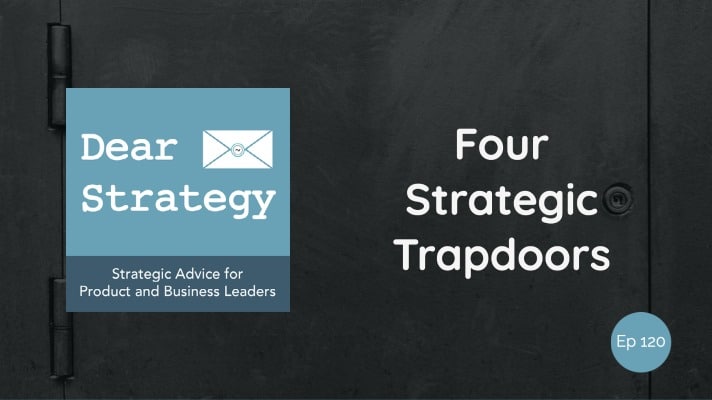On this episode of Dear Strategy, we answer the following question…
Dear Strategy:
“What are the most important traps and/or disruptions to implementing a strategy?”
I’ve been waiting all year for another question that I can answer in the form of a “listicle!” The last post that I presented in this format was called “The 5 Biggest Product Strategy Pitfalls to Avoid.” (And I even won an award for that one!) Those pitfalls, by the way, were:
- Not Having a Strategy
- Overanalyzing Your Current Situation
- Assuming That Your Strategy Will Be Free
- Presenting the Strategy You Think Your Leaders Want to Hear
- Not Socializing Your Strategy
So what exactly is the difference between a pitfall and a trapdoor? Nothing really – except that the pitfall post was about things to avoid when creating your strategy, while this one is going to be about things that can get in the way of implementing your strategy. And, yes, there will invariably be some overlap – but certainly nothing that isn’t worth repeating anyway!
So, without further ado, I give you the four strategic trapdoors that could get in the way of implementing your otherwise outstanding strategic plan…
Trapdoor #1 – Life
It’s January and you’ve just been informed that the annual update of your strategic plan is due by the end of March. It’s kind of a big deal because you’ll be presenting your plan to your company’s executive leadership team, which, as everyone knows, can be something of a make or break situation as far as your career goes. So you spend the next 3 months vigorously preparing for the “big show” – gathering all of your data, dotting all your i’s, crossing all your t’s, and putting all the perfect finishing touches on your 30-slide PowerPoint deck. You deliver your strategy, and it’s everything your management team wants to hear – huge rounds of applause all around. Congratulations, by the way! It’s been quite the marathon getting here. And, just as you might want to do after running an actual marathon (I’m assuming, of course), you now want to take a nice, long, well-deserved rest from the entire strategic process. Plus, your day job has really started to pile up. So you mentally scrawl a big “A+” across your strategy deck, put it aside, and get back to life. And you do that for exactly the next 9 months until you have to start the entire process all over again.
Yes – it sounds completely counterintuitive when you write it out like this. But, in reality this is the exact scenario that I see playing out over and over again in the corporate world almost every single day. The strategic process somehow becomes an event, and then “real life” takes over once that event has been completed.
Of course, the remedy to this is to develop a strategy that actually guides your life rather than the other way around. And, in that case, your strategy “event” would simply be to provide your management team with an update on the plan you’re already executing instead of having to reinvent a new plan based on whatever reality you think your management team wants to see. But I digress (and will leave that discussion for another post). For now, let’s just say that if your strategy (or your strategy process) isn’t realistic, eventually, real life is going to step back into the picture. And that’s going to be a pretty difficult trap to avoid.
Trapdoor #2 – Money
I’ve covered this point many times before – including in the pitfall post that I referenced earlier. No strategy is free – of that we can be certain. So you need to account for that when putting together your plan. But as much as you need to match your investments to your goals when it comes to creating your strategy, you also need to be willing to actually spend that money when it comes to implementing your strategy.
Sound too obvious? Well, let’s look at how this situation could play out if you’re not careful…
You develop your strategy and account for all the investments that will be required in order to carry out your plan. Then, just as you begin to implement your plan, your company goes through budget cuts. Well, of course it does – that’s why you needed a strategy in the first place! It’s not that your leadership doesn’t want to invest in your plan, but they need to make the quarter, and there’s absolutely no way that your shareholders will be willing to wait months, or even years, for things to start turning around. So your investment request gets pulled back. But what doesn’t get pulled back are your goals and objectives! And so begins the downward spiral of overpromising, underdelivering, and having to answer for failures that, in reality, you don’t really own.
Unfortunately, this kind of thing happens all the time in the world of strategic planning. And although much of the remedy has to do with tightening up the circle of expectations between employees, leaders, and shareholders, as a strategist, you can do your part by being very clear about the interdependency between your required investments and your projected results. And if the money is pulled and you’re told, “you need to hit your numbers anyway,” then that should buy you just enough time to land a job with a company that fosters true collaboration over top-down demands.
“As much as you need to match your investments to your goals when it comes to creating your strategy, you also need to be willing to actually spend that money when it comes to implementing your strategy.”
Trapdoor #3 – Change
On a slightly less cynical note, our third trapdoor has to do with something that is absolutely going to happen no matter what you do. That is, things are going to change. Companies change, customers change, competitors change – it’s just the way life is. The best you can do is try to predict that change wherever and whenever possible, and then have a plan in place to address it in a way that allows you to achieve your strategic goals.
When you think about strategy in a military context, this idea of predicting change seems obvious. You study yourself, your enemy, and your environment, and then you use that information to make assumptions about how you think each of those elements are going to interact with one another. Then, when one or more of those assumptions are wrong, or when one or more of those elements change, you know exactly where to plug that new information back into your strategy so you can adapt your plan to the latest reality.
In a business context, we tend to think in terms of a “situation analysis” – meaning that we analyze how things are today without spending enough time thinking about how those things are going to change in the future. Then, when things inevitably do change, we’re somehow caught off guard; even to the point of going back and starting our plans all over again from scratch.
As far as a remedy, the key is to use your situation analysis to make assumptions about the future, and also to understand the effects that those assumptions are likely going to have on the outcome of your plan. With that information in hand, you’ll be better equipped to deal with any changes that occur by simply plugging them back into the appropriate place in your strategy – which, believe me, is going to be a heck of a lot less painful then starting your plan all over again from the beginning .
Trapdoor #4 – Formality
The last barrier I typically see when it comes to successfully executing a strategy has to do with formality – or, more accurately, the lack thereof.
Strategic planning is an intuitive artform. Given our discussion above about making assumptions and predicting the future, there’s no doubt that your strategic planning process is going to involve a lot of “gap-filling” as far as data and analytics are concerned. Because of that, it might be tempting to think that you can simply forego any amount of formality in your planning process and just use your gut as your main guide.
Believe it or not, I’m very much in favor of developing strategies based purely on your gut instincts, provided that; 1) you actually have a good gut instinct, and; 2) you’re going to be executing your strategy as a solo act. So, let’s tackle these one at a time…
On the first point, there are absolutely some truly exceptional people out there that seem to have the innate ability to see what most others simply cannot. And they do this with seemingly very little data or analysis to serve as their guide. Steve Jobs is the name that most often comes up when describing such a person, but you could easily put Elon Musk, Jeff Bezos, or any number of other uber-successful entrepreneurs into that same category. Now, not knowing any of these individuals personally, I can’t really say how much time they put into truly understanding their situations before determining what their next moves are going to be. But I can say that the number of people who seem to possess this ability to accurately assess a situation with little to no supporting data or effort are few and far between. So it’s probably not wise to assume that any of us mere earthlings can get away with pulling this off with any degree of regularity or accuracy.
But even if we can get past the first point, there’s still the second point that will almost always get in the way. That is, if you plan to lean on a team of people to help you implement your strategy (which almost all of us will to some extent), then you’re going to need an effective way of communicating with your team to ensure that everyone remains on the same page. And the way you’re going to do that is to inject some level of formality into your process.
So what does that formality look like? It’s really not as complicated as it may sound. In fact, it may involve nothing more than following a concise, yet structured framework that’s easy to understand, easy to follow, and easy to implement. Strategy can get really deep and really complicated if you let it – especially when it’s taught in an academic context. But you really don’t need a degree to be a good strategic planner. What you do need is a process. And not having (or following) such a process is one of the most common strategic trapdoors that I see, especially during the implementation stage.
So there’s my listicle for 2020 – meaning that I doubt I’ll do another one until sometime next year! So, if you have an idea of what you might want that listicle to be about, just drop a note in the comments below. And then maybe… just maybe… I’ll incorporate it into my longer-term plan!
Listen to the podcast episode
Dear Strategy: Episode 120

Are you interested in strategy workshops for your product managers or business leaders? If so, please be sure to visit Strategy Generation Company by clicking the link below:
 Bob Caporale is the founder of Strategy Generation Company, the author of Creative Strategy Generation and the host of the Dear Strategy podcast. You can learn more about his work by visiting bobcaporale.com.
Bob Caporale is the founder of Strategy Generation Company, the author of Creative Strategy Generation and the host of the Dear Strategy podcast. You can learn more about his work by visiting bobcaporale.com.






